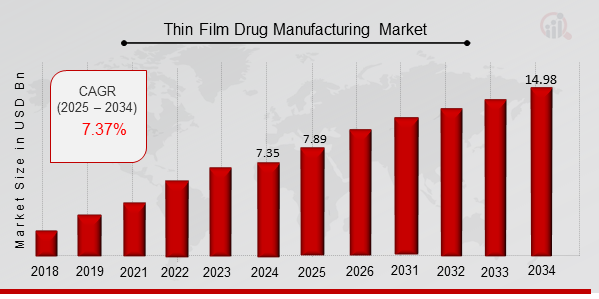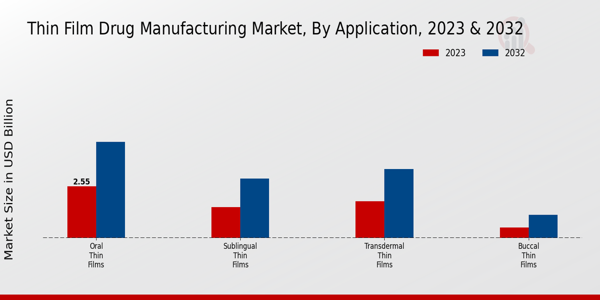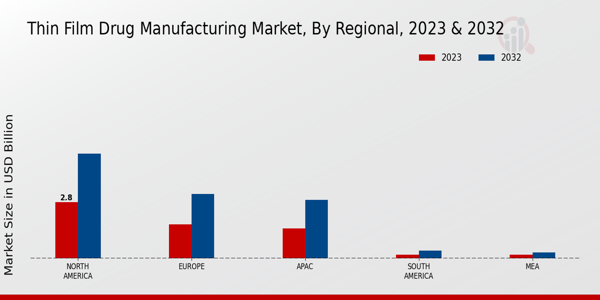Thin Film Drug Manufacturing Market Overview
As per MRFR analysis, the Thin Film Drug Manufacturing Market Size was estimated at 7.35 (USD Billion) in 2024. The Thin Film Drug Manufacturing Market Industry is expected to grow from 7.89 (USD Billion) in 2025 to 14.98 (USD Billion) till 2034, at a CAGR (growth rate) is expected to be around 7.37% during the forecast period (2025 - 2034).
Key Thin Film Drug Manufacturing Market Trends Highlighted
The Thin Film Drug Manufacturing Market is experiencing several noteworthy trends. One of the key drivers of this market is the increasing demand for innovative drug delivery systems that enhance the bioavailability of medications. As healthcare providers and patients seek more effective treatment options, the focus on formulations that allow for rapid absorption and targeted delivery continues to grow. This shift in preference highlights the importance of thin film technologies, which are capable of delivering drugs in a manner that is less invasive and more patient-friendly.
Additionally, opportunities to explore this market include the rising prevalence of chronic diseases and the resulting need for better therapeutic solutions.
Companies can capitalize on advancements in materials science and nanotechnology, which are paving the way for more efficient manufacturing processes. This not only improves production efficiency but also opens avenues for creating more complex drug formulations. Potential collaborations between pharmaceutical firms and tech companies also represent an area ripe for growth, as the integration of digital technologies into drug manufacturing processes could enhance precision and reduce production costs. Recent trends indicate a shift towards personalized medicine, fueling the need for tailored drug delivery solutions.
The market is seeing an increase in the development of customizable thin film products that cater to individual patient needs.Furthermore, sustainability concerns are prompting manufacturers to adopt eco-friendly materials and practices, which not only align with global environmental goals but also appeal to conscious consumers. The convergence of these trends positions the thin film drug manufacturing market as an innovative leader in the pharmaceutical landscape, poised to meet future healthcare demands effectively.

Source: Primary Research, Secondary Research, Market Research Future Database and Analyst Review
Thin Film Drug Manufacturing Market Drivers
Increasing Demand for Advanced Drug Delivery Systems
The Thin Film Drug Manufacturing Market Industry is witnessing a significant uptick in demand for advanced drug delivery systems. Patients are becoming increasingly aware of the benefits associated with thin film drug formulations, which enable rapid absorption, convenience, and ease of use. The advent of personalized medicine has further driven this trend, as healthcare providers seek to enhance therapeutic outcomes by tailoring drug delivery methods to individual patient needs.Additionally, the rise in chronic diseases and the aging population have amplified the need for more effective drug delivery systems.
As the Thin Film Drug Manufacturing Market expands, investments in innovative technologies are expected to play a crucial role in overcoming challenges associated with traditional drug delivery methods. This shift towards advanced systems indicates a broader industry move towards optimizing efficacy and patient compliance, which will further stimulate market growth.The integration of smart technologies into drug delivery mechanisms is an emerging trend within the Thin Film Drug Manufacturing Market Industry, which will allow for real-time monitoring of drug delivery and patient adherence, thereby providing healthcare professionals with valuable insights into treatment regimens.
These developments not only position thin film drug delivery at the forefront of pharmaceutical innovation but also represent a key driver for sustained growth in the coming years.
Technological Advancements in Manufacturing Processes
Technological advancements in manufacturing processes are significantly contributing to the growth of the Thin Film Drug Manufacturing Market Industry. Innovations in production technologies, such as roll-to-roll processing and advanced coating methods, have enhanced the efficiency and scalability of thin film drug production. These advancements enable manufacturers to produce high-quality films with precise thickness and uniformity, resulting in improved drug performance and patient outcomes.As technology continues to evolve, the cost-effectiveness and accessibility of thin film formulations are also expected to improve, making them more appealing to a broader market.
The ongoing research and development efforts in this domain further underscore the potential for new applications, which will continue to propel the Thin Film Drug Manufacturing Market forward.
Growing Prevalence of Chronic Diseases
The growing prevalence of chronic diseases such as diabetes, cardiovascular conditions, and neurological disorders is a key driver for the Thin Film Drug Manufacturing Market Industry. As these diseases require long-term management, the demand for efficient and patient-friendly drug delivery methods has increased. Thin film formulations offer a practical solution by allowing for ease of administration and enhanced patient compliance.
This trend is particularly important in the context of global health challenges, where the need for innovative therapies is more pressing than ever.With the increasing focus on chronic disease management, the adoption of thin film drug manufacturing technologies is expected to rise, further contributing to market expansion.
Thin Film Drug Manufacturing Market Segment Insights
Thin Film Drug Manufacturing Market Application Insights
The Thin Film Drug Manufacturing Market focuses on various applications, with a total market valuation of 6.38 USD Billion in 2023 and expected growth towards 12.1 USD Billion by 2032. A key area within this segment is Oral Thin Films, which notably holds a market share valued at 2.55 USD Billion in 2023, demonstrating its strong position and majority holding in the market due to the increasing demand for convenient dosage forms and easier administration for patients. This segment is significant as it caters to a diverse range of therapeutic applications that require quick drug delivery.
Meanwhile, Sublingual Thin Films represent another important application with a valuation of 1.52 USD Billion in 2023, highlighting its essential role in the rapid absorption of drugs directly into the bloodstream, which is particularly vital for emergency medication and pain management therapies. Transdermal Thin Films are also noteworthy, valued at 1.81 USD Billion in 2023, as they serve the growing need for continuous drug delivery with minimal discomfort, making them increasingly popular in chronic pain and hormone replacement therapies.
On the other hand, Buccal Thin Films, while smaller in contribution with a valuation of 0.5 USD Billion in 2023, cater to a niche market, addressing specific medical needs such as the administration of nicotine replacement therapies and certain vaccinations.Analyzing the Thin Film Drug Manufacturing Market data reveals that Oral and Sublingual Thin Films dominate the market as they fulfill critical patient needs for rapid delivery and ease of use, driving their demand.
Factors such as advancements in drug formulations, increasing incidence of chronic diseases, and a growing preference for non-invasive drug delivery systems are acting as growth drivers in this industry. However, challenges such as stringent regulatory approvals and manufacturing complexities remain significant hurdles.
The market continues to evolve, offering opportunities for innovation and growth, especially in the realm of personalized medicine and targeted drug delivery systems, highlighting the importance of the application segment in shaping the future of drug administration methods.The Thin Film Drug Manufacturing Market statistics reflect a vibrant and adaptive landscape that underlines the importance of ongoing research and development to address patient needs in drug delivery applications.

Source: Primary Research, Secondary Research, Market Research Future Database and Analyst Review
Thin Film Drug Manufacturing Market Drug Type Insights
The Thin Film Drug Manufacturing Market, valued at 6.38 USD Billion in 2023, exhibits significant diversity within its Drug Type segment, encompassing categories such as Analgesics, Antiemetics, Antihistamines, and Hormones. These categories contribute to the evolving landscape of drug delivery systems, which are becoming essential components in enhancing therapeutic efficacy and patient compliance. Analgesics, widely utilized for pain relief, play a crucial role owing to their demand in chronic pain management, while Antiemetics are significant for managing nausea and vomiting, especially in chemotherapy patients.
Antihistamines, effective in treating allergic reactions, dominate the market due to their widespread application in various health conditions. Hormones, critical for various physiological functions, are increasingly being administered in thin film formats to ensure better absorption. Collectively, these Drug Types significantly impact the Thin Film Drug Manufacturing Market as trends such as patient-centric solutions and innovations in drug delivery systems continue to drive market growth. The market data reflects a robust trajectory as it adapts to evolving healthcare needs, constantly addressing challenges while exploring new opportunities within this pivotal segment.
Thin Film Drug Manufacturing Market Material Type Insights
The Thin Film Drug Manufacturing Market, valued at 6.38 USD Billion in 2023, showcases a diverse segmentation that includes various material types. Among these, Polymer-Based Films are significant due to their advantageous properties, such as flexibility and biocompatibility, making them essential in the delivery of medications. Metal-Based Films also play a critical role, particularly in enhancing the stability and bioavailability of medications, which helps in addressing various drug delivery challenges. Meanwhile, Nanoparticle-Based Films are gaining traction for their ability to facilitate targeted drug delivery systems, thus improving therapeutic efficacy.
The demand for these materials drives innovation and is influenced by factors such as increasing global disease burden and advancements in drug formulations. The segmentation of the Thin Film Drug Manufacturing Market highlights the importance of these materials in the overall market growth and the opportunities they present for manufacturers in enhancing therapeutic outcomes. The market continues to evolve with ongoing research into new material formulations, emphasizing the value of this segment in improving patient care and treatment results.
Thin Film Drug Manufacturing Market Manufacturing Technique Insights
The Thin Film Drug Manufacturing Market, valued at 6.38 billion USD in 2023, shows a robust landscape driven by various manufacturing techniques. Among these, methods such as Solvent Casting, Hot Melt Extrusion, and Spray Drying have been pivotal in enhancing drug delivery systems. Solvent Casting has gained traction due to its flexibility and effectiveness, providing consistent film qualities. Hot Melt Extrusion dominates the market because of its ability to produce uniform dosages and improved bioavailability, significantly benefiting pharmaceutical applications.
Spray Drying stands out for its efficiency in converting liquid solutions into powder forms, which can enhance stability and ease of storage. Overall, these techniques play a crucial role in increasing the efficiency and effectiveness of drug formulations, contributing to the anticipated market growth with a projected value of 12.1 billion USD by 2032. The rapid growth in the pharmaceutical sector and evolving healthcare needs are key factors propelling advancements in the Thin Film Drug Manufacturing Market, with the global market data reflecting significant opportunities in innovative manufacturing processes.
Thin Film Drug Manufacturing Market Regional Insights
The Thin Film Drug Manufacturing Market is experiencing steady growth across various regions, with a total estimated value of 6.38 USD Billion in 2023. North America leads the market, dominating with a significant valuation of 2.8 USD Billion that is expected to rise to 5.2 USD Billion by 2032, reflecting its strong healthcare infrastructure and innovation in drug delivery systems. Europe follows, valued at 1.7 USD Billion in 2023, expected to increase to 3.2 USD Billion, driven by rising investments in research and development.
The APAC region holds a value of 1.5 USD Billion in 2023, projected to grow to 2.9 USD Billion, offering opportunities due to increasing healthcare needs and a growing aging population.South America and MEA show comparatively lower figures, with 0.2 and 0.18 USD Billion in 2023, respectively, but are on an upward trend, indicating emerging market potential. The Thin Film Drug Manufacturing Market statistics reveal a regional diversity in growth, with North America and Europe holding major portions, while APAC shows significant growth opportunities, potentially contributing to future market advancements.

Source: Primary Research, Secondary Research, Market Research Future Database and Analyst Review
Thin Film Drug Manufacturing Market Key Players and Competitive Insights
The Thin Film Drug Manufacturing Market has witnessed significant advancements and competitive dynamics driven by the increase in demand for customized drug delivery systems. As pharmaceuticals strive for enhanced bioavailability and patient adherence, thin film technology emerges as a compelling solution. Companies operating in this market are leveraging innovative techniques in drug formulation, such as sublingual and buccal films, which provide improved absorption rates and rapid onset of action. Furthermore, the growing trend towards personalized medicine and the need for non-invasive drug delivery methods have promoted the development of thin film technologies, fostering increased competition among key players.
The landscape is characterized by strategic collaborations, mergers, and acquisitions, as companies aim to broaden their product offerings while enhancing their market foothold.Pfizer holds a substantial presence in the Thin Film Drug Manufacturing Market, distinguished by its robust research and development capabilities. The company has made significant investments in innovative drug formulations, capitalizing on thin film technologies to enhance patient compliance and efficacy. Pfizer’s strengths lie in its established global distribution networks, allowing for efficient market penetration and access to diverse patient populations.
Additionally, the company focuses on leveraging advanced technologies and state-of-the-art manufacturing processes, enabling it to produce high-quality thin film drug products. This commitment to innovation and quality assurance positions Pfizer favorably against its competitors, helping to solidify its market leadership and reputation within the thin film sector.Roche is another significant contender in the Thin Film Drug Manufacturing Market, known for its dedication to unlocking the potential of personalized medicine. The company's strength lies in its ability to integrate biotechnology with advanced drug delivery systems, including thin films, to provide targeted therapies that cater to specific patient needs.
Roche's emphasis on research and development enables it to stay at the forefront of innovative technologies, ensuring that its thin film products remain competitive and effective. Moreover, Roche’s commitment to strategic partnerships and collaborations enhances its product portfolio, allowing it to synergize with other innovative firms and drive advancements in thin film drug manufacturing. Furthermore, its strong position in diagnostics complements its pharmaceutical capabilities, enabling Roche to offer comprehensive healthcare solutions that are increasingly sought after in the evolving landscape of drug delivery methods.
Key Companies in the Thin Film Drug Manufacturing Market Include
Thin Film Drug Manufacturing Market Industry Developments
The Thin Film Drug Manufacturing Market is witnessing significant advancements and growing interest from major pharmaceutical players. Recently, Pfizer has been enhancing its thin film technology platform to expand its product range and improve patient compliance. Roche has been actively exploring new delivery systems involving thin films to target unmet medical needs. Bristol Myers Squibb is focusing on strategic collaborations to innovate within this domain. Meanwhile, Mylan, now part of Viatris, is leveraging its expertise to increase its presence in thin film applications. Eli Lilly continues to push the boundaries of drug formulation with its investments in thin film technologies.
Current market trends indicate robust growth, driven by the increasing demand for convenient drug delivery systems and personalized medicine. Companies like Merck & Co. and Novartis are also aligning their strategies to capitalize on emerging opportunities in thin film manufacturing. The competitive landscape is dynamic, with several organizations engineering collaborations and product launches to enhance their market foothold, reflecting a broader trend in healthcare that prioritizes efficient drug delivery mechanisms and improved patient outcomes.
Thin Film Drug Manufacturing Market Segmentation Insights
Thin Film Drug Manufacturing Market Application Outlook
Thin Film Drug Manufacturing Market Drug Type Outlook
Thin Film Drug Manufacturing Market Material Type Outlook
Thin Film Drug Manufacturing Market Manufacturing Technique Outlook
Thin Film Drug Manufacturing Market Regional Outlook
| Report Attribute/Metric |
Details |
| Market Size 2024 |
7.35 (USD Billion) |
| Market Size 2025 |
7.89 (USD Billion) |
| Market Size 2034 |
14.98 (USD Billion) |
| Compound Annual Growth Rate (CAGR) |
7.37 % (2025 - 2034) |
| Report Coverage |
Revenue Forecast, Competitive Landscape, Growth Factors, and Trends |
| Base Year |
2024 |
| Market Forecast Period |
2025 - 2034 |
| Historical Data |
2020 - 2024 |
| Market Forecast Units |
USD Billion |
| Key Companies Profiled |
Pfizer, Roche, Bristol-Myers Squibb, Mylan, Eli Lilly, Celgene, Johnson and Johnson, AstraZeneca, Amgen, Teva Pharmaceuticals, AbbVie, Merck and Co., GSK, Novartis, Sanofi |
| Segments Covered |
Application, Drug Type, Material Type, Manufacturing Technique, Regional |
| Key Market Opportunities |
Rising demand for personalized medicine, Technological advancements in drug delivery, Growing prevalence of chronic diseases, Increasing investments in pharmaceutical R, Expansion of healthcare infrastructure globally |
| Key Market Dynamics |
Rapid technological advancements, Increasing demand for transdermal therapies, Growing prevalence of chronic diseases, Rising focus on patient compliance, Expanding pharmaceutical R investment |
| Countries Covered |
North America, Europe, APAC, South America, MEA |
Frequently Asked Questions (FAQ):
The Thin Film Drug Manufacturing Market is expected to be valued at 14.98 USD Billion in 2034.
The expected CAGR for the Thin Film Drug Manufacturing Market from 2025 to 2034 is 7.37%.
North America is projected to have the largest market share, valued at 5.2 USD Billion in 2032.
The market size for Oral Thin Films is projected to reach 4.75 USD Billion in 2032.
Major players include Pfizer, Roche, Bristol-Myers Squibb, Mylan, and Eli Lilly among others.
Sublingual Thin Films are expected to be valued at 2.92 USD Billion in 2032.
The Transdermal Thin Films segment is expected to be valued at 3.4 USD Billion in 2032.
The market value for Buccal Thin Films is projected to be 1.13 USD Billion in 2032.
The estimated market size for Europe is expected to reach 3.2 USD Billion in 2032.
The expected market value for the APAC region is projected to be 2.9 USD Billion by 2032.

















